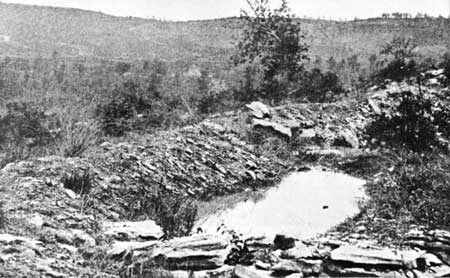|
CHICKAMAUGA and CHATTANOOGA National Military Park |
 |

Missionary Ridge from a Union trench.
From Elson, The Civil War Through the Camera.
Lifting the Siege—The Battle of Chattanooga (continued)
THE BATTLE ABOVE THE CLOUDS, NOVEMBER 24. While operations were in progress, east of Chattanooga, Hooker moved into action west of the town. The failure of Osterhaus' Division to join Sherman resulted in another change of orders. A new plan for Hooker to take Lookout Mountain and descend into Chattanooga Valley replaced the original one of having him merely hold Lookout Valley and the route to Bridgeport. Hooker had three divisions in his force commanded by Brigadier Generals Peter J. Osterhaus, John W. Geary, and Charles Cruft, each from a different army corps. Geary was on the right at Wauhatchie, Cruft in the center, and Osterhaus near Brown's Ferry. It was a unique team. One who was present wrote, "We were all strangers, no one division ever having seen either of the others."
The terrain that confronted Hooker's command was rugged, steep, heavily timbered, and topped by a rocky cliff. At the northern end, at the cliff base and halfway up the mountain, was a bench of nearly level land. On it stood the Cravens Farm. At 8 a. m. on November 24 Hooker sent Geary's Division, supported by a brigade from Cruft's Division, to effect a crossing of Lookout Creek. The troops accomplished this with little opposition and Geary climbed the mountain until the head of his column reached the cliff. The division then moved to the left and proceeded northward toward the point of the mountain.
While Geary climbed the mountain, Cruft, with his force, moved farther down the valley toward the Tennessee River and seized a bridge over the creek. Osterhaus's Division then crossed the stream at that point in the face of sharp skirmishing with Confederate defenders before the latter retreated up the mountain. The three Union divisions soon joined on a common line and, supported by Union batteries on Moccasin Point, steadily drove Walthall's Confederate brigade around the point of Lookout Mountain to the Cravens farmhouse. By noon, Hooker's forces were in possession of the farm but the Confederates made a stand beyond the Cravens house within prepared defense works, and were joined there by two brigades from the top of the mountain. Fog which coveted the mountainside most of the morning became so heavy that by 2 p. m. it was almost impossible to see. This factor, plus a shortage of ammunition, caused Hooker to halt and consolidate his position. Later in the afternoon, Carlin's brigade arrived with a resupply of ammunition.
During the night, General Stevenson withdrew the Confederate forces from Lookout Mountain and marched them to Missionary Ridge where they joined their comrades holding that sector of the line.
"The Battle Above the Clouds" was fought on the bench of land surrounding the Cravens house. There was no fighting on top the mountain. The romantic name given in later years to this action on the Union right was the result of the fog and mist which shrouded the mountain that day from observers below. It was not until the next morning that the 8th Kentucky Volunteers planted the Stars and Stripes on top of the bluff.

|

|
| History | Links to the Past | National Park Service | Search | Contact |
|
Last Modified: Fri, May 17 2002 10:00:00 pm PDT |


